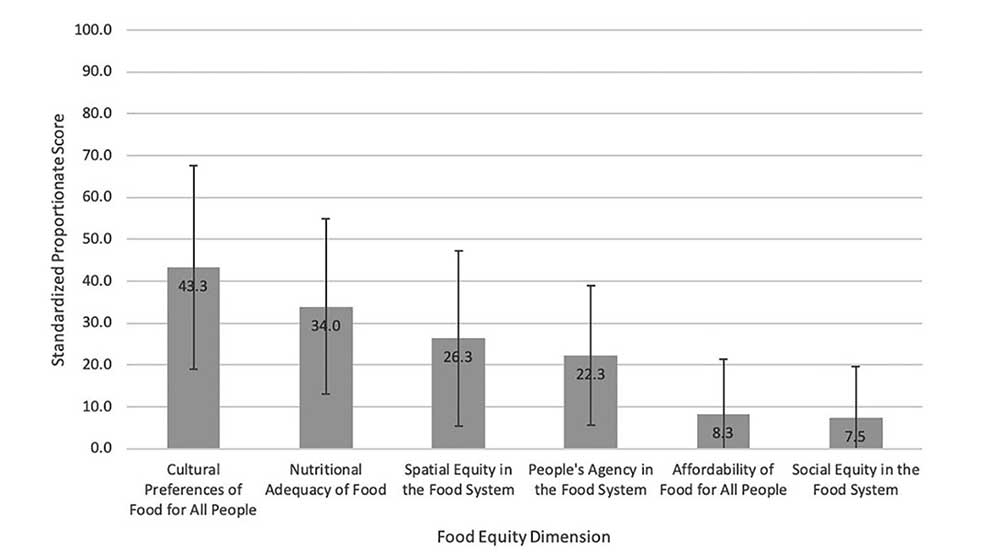Uncovering JAPA
Food For the People: Planning For Equitable Regional Food Systems

Food systems are intricate networks that span entire regions and are linked to transportation, the economy, and the environment, among other sectors; yet, the field of food systems planning remains underdeveloped, and equitable regional food systems plans are rare. In a recent Journal of the American Planning Association article, "Planning for Regional Food Equity" (Vol. 87, No. 3), authors Yeeli Mui, Maryam Khojasteh, Alexandra Judelsohn, Avery Sirwatka, Sylvia Kelly, Patrick Gooch, and Samina Raja examine how 47 regional plans address food equity.
Food Systems Planning Aims for Equity
A planning practice that had not been embraced until the 21st century, food systems planning strives to promote food equity and social justice along racial, economic, and geographic lines within local and regional areas. Little systematic evaluation of food systems-related plans exists, and the authors determined that most food systems components of regional plans are narrowly focused, addressing the symptoms of structural issues without tackling the upstream problems. Therefore, they conclude, that regional plans have fallen short in promoting food equity.
The authors begin by characterizing six key dimensions of an equitable regional food system:
- Nutritional adequacy of food
- Food affordability for all people
- Cultural preferences of food for all people
- Social equity in the food system
- Spatial equity in the food system
- People's agency in the food system
Drawing on a sample of 549 regional plans resulting from a national search, just 47 met their criteria that the plan be adopted or endorsed by a regional government of a consortium of local governments, the plan describes future land uses of the region and the plan address issues related to food including agriculture and food production and other sectors.
The small sample indicates the prevailing lack of attention paid to food systems in regional plans as well as the lack of coordination of municipalities within regions of the U.S. to promote food equity. For the 47 plans included in their study, the authors developed their evaluation instrument, as none previously existed for analyzing food equity.

Figure 1: Comparison of average standardized proportionate scores for each food equity dimension. A standardized proportionate score for each of the six food equity dimensions was calculated by dividing the total raw score by the number of indicators in each food equity dimension and multiplying it by 100. For example, across the sampled regional plans (n = 47), the dimensions of "cultural preferences of food for all people" received an average score of 43.3 points (SD 24.2). The bars in the figure represent the standard deviation of the average standardized proportionate score for each food equity dimension.
Food Equity in Regional Planning Recommendations
Ultimately, the authors' findings were disappointing, but their recommendations are optimistic. All plans on average scored relatively low in the dimensions of food equity. While the planning processes of some plans reported engaging with diverse stakeholders, equity in the food system remained a low priority in the plans overall. Also, the plans failed to address how they would monitor progress toward their goals, a long-standing issue in planning of all types. The authors offer suggestions for incorporating food equity into various types of regional plans, such as transportation and economic plans, and they recommend a more robust use of data to strengthen proposed actions and establish measurable benchmarks.
Food systems are at the nexus of regional planning and public health, two fields that have historically had deep links but became more distant before recently recognizing their ties more formally again. The lack of equity within food systems plans highlights the urgent need for even better intersectoral coordination.
Furthermore, food systems planning is hindered by the geographic fluidity of food networks. Food systems do not conform neatly to the boundaries of our nation's states and municipalities, yet regional coordination must exist to produce plans that address each of the authors' six dimensions of equitable food systems. For the sake of equity and social justice in food systems and health, planners must have the flexibility to maneuver outside of the bounds of their field and their geography.
Top image: Seattle Parks and Recreation – flickr.com (CC by 2.0)


